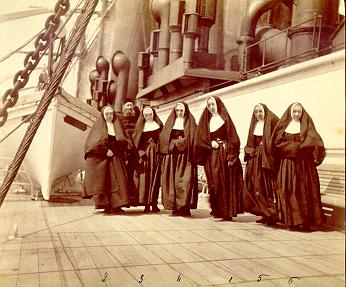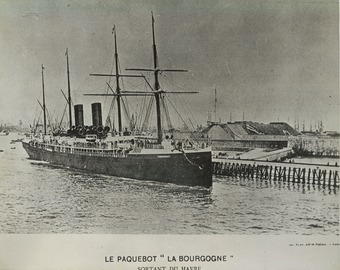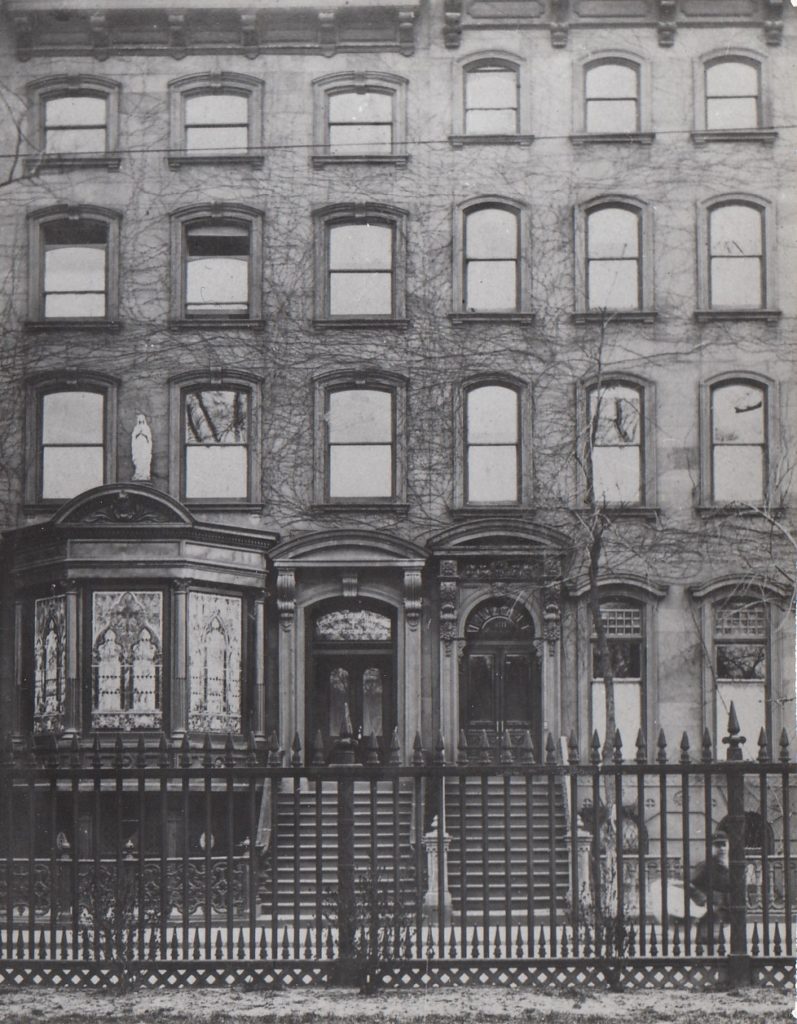First foundation of the Little Sisters of the Assumption in New York in April 1891

April 1891. Six Little Sisters of the Assumption pose on an ocean liner. The wind swells their veils and heavy skirts. A priest accompanies them.
Where are they going? And who are they?
They are leaving for America: it was the first time Little Sisters were leaving Europe and crossing the Atlantic.
They left on board the liner “Le Bourgogne” from the port of Le Havre.

Their names: Sr Marie Anna (Alphonsine Foulon), Sr Marie Alexandrine (Julienne Andrieu), Sr Marie Laetitia (Charlotta Quay), Sr Marie Euphrasie (Marie Maas), Sr Marie Bernardine (Louise Rinquebach, who left the congregation in 1895), with their sister-in-charge, Mother Marie du Christ (Antoinette de Godin). The priest accompanying them was Father Brun, Augustin of the Assumption. He had been one of Father d’Alzon’s first companions (like Father Pernet), and would be the chaplain of the new community until his death in 1895.
In the New York press, they were announced as follows: “Six women among the passengers of the steamer ‘La Bourgogne’ […]are coming to care for the poor sick of New York, without distinction of faith, nationality or colour.”
How did the Congregation come to found a , as it was then called, in North America?
Before joining the LSA, Mother Marie du Christ had been a governess in a family, and two of the children she had looked after, who had become ‘ladies’, had subsequently remained very close to her. It was these ladies who told the Archbishop of New York at the time, Archbishop Corrigan, about LSA. It was he who repeatedly asked Father Pernet to found the congregation in his diocese, as early as 1888. The foundation was delayed because the LSA asked that the Augustinians of the Assumption (AA) also be allowed to open a community in New York, which Bishop Corrigan refused. He subsequently agreed that Father Brun could come at the same time as the LSA, and the AA opened a community after his death in 1895.
The voyage aboard the “Bourgogne
Let’s go back to April 1891. The voyage lasted 9 days. Of course, the sisters were not exempt from the inconveniences of such a voyage, in particular seasickness. Nonetheless, the journey was generally calm. The ship was state-of-the-art. The diary written by one of the sisters during the voyage reads: “There is unlimited light and water in the cabin. The first is electric; without lighting a match, it appears as if by magic; you push a small hook to the right, and the bright flame appears; you push it to the left and it disappears“.
Those who are not ill study, mainly English, at least for the two who do not yet know the language. The newspaper’s editor tells us, for instance, that one day, in order to practice her English, Sr Anna had come to ask MM du Christ if she could cut her hair, and in her sentence had confused hair and head, asking if she had permission to cut her head! The rest of the time, some of them knit, read or rest. They are also in contact with other passengers, families in particular, many of whom are Protestant.
On a spiritual level, they try to maintain a regular life: they have mass, even if they have to ask for permission to use one of the lounges each time, and the roll regularly complicates things. They also try to maintain their regular prayers and meditations..
Arrival in New York
Upon their arrival in New York, after a period of quarantine due to a case of typhus on the ship, the sisters were finally able to disembark. For the first three weeks, they stayed with the Sisters of Bon Secours of Troyes, while they looked for a house.
It initially all went well, but a first challenge awaited the little group: one of them, Sr M. Euphrasie, contracted typhoid while caring for a patient. She quickly died of it. She was 26 years old.
Soon, the missionaries in New York had no shortage of missions to fulfil: of course, they worked with the sick in their homes, but they also set up a group of Lady Servants[1][A1] , a Fraternity, the Daughters of Saint Monica[2], etc.
In 1892, they acquire a new house. This house overlooks a park, which the sisters much appreciate given the absence of a garden. Father Pernet visits them for the first time in 1893.

The House of the Little Sisters in New York, acquired in 1892, at n°312, on 15th Street [
Eventually, the Little Sisters opened another community in New York, in Harlem, in 1900 (until 1964) and several others in the 1970s and 1980s. From then on, they also established themselves in several other cities in the United States (Philadelphia in 1922 and Woonsocket in 1936, for example) and in Canada (1933). In all these cities, they continue their mission of: caring for the sick and the children, cooking and all the domestic activities that need to be done when the mother is ill or unable to attend. When it’s possible, they also take advantage of the opportunity to teach catechism or to enable families to reconnect with religion when this link has been lost.
In 1991, 100 years after the foundation in New York, there were 12 communities of Little Sisters in the United States.
Today, they are few and old, but they have passed on their mission to lay people who are committed to helping the most disadvantaged, as the LSAs did for so long. There are several examples: Pernet Family Health Service, created in 1967 in Worcester, where the LSAs had been present since 1955 ( https://www.pernetfamilyhealth.org/ ), LSA Family in Mission (https://www.lsafim.org/), Project Hope Boston (https://www.prohope.org/ ), LSA Family Health Service ( https://littlesistersfamily.org/ )
Céline Hirsch
Archives of the Little Sisters of the Assumption
[1] Dames Servantes des Pauvres (Ladies Servants of the Poor): a group of lay women from wealthy backgrounds who got involved with the LSA.
[2] At the time, the Daughters of Saint Monica were the equivalent for women of the Fraternities set up by Father Pernet to teach workers in the Christian faith..

3 Responses
It is so inspiring to read that the Sisters cared for the poor workers ..across all the divides of ‘race ,creed or color’ Let is continue to be instruments of peace ,love and compassion
I love and admire the risks that the LSA took back then in the name of helping families. as a recipient of their services. it’s their mission, charism their commitment to the poor. that gives me strength every day to get up and be present to the service. gracias
Just as I opened the amazing link to the archives I found the title “First founding of the Little Sisters of the Assumption in New York in April 1891” With a little imagination I recreated this amazing journey full of love and courage of the six Little Sisters of the Assumption in April 1891. I then traveled back in time and was able to see the incredible results that the community of the Little Sisters has developed quietly and without fuss for the benefit of hundreds of families with whom they have established strong bonds of closeness. What impressed me most was the deep spirituality, kindness, and profound love for the most vulnerable that they encountered on their missionary journey.